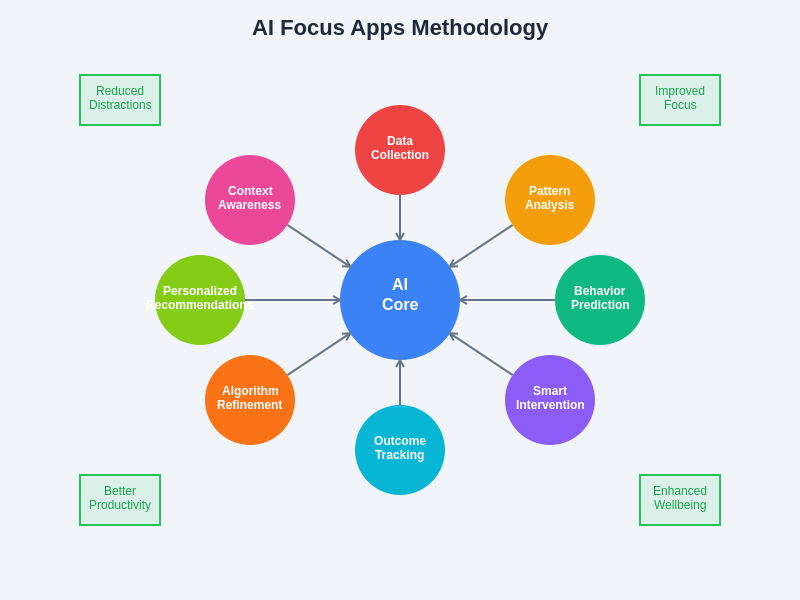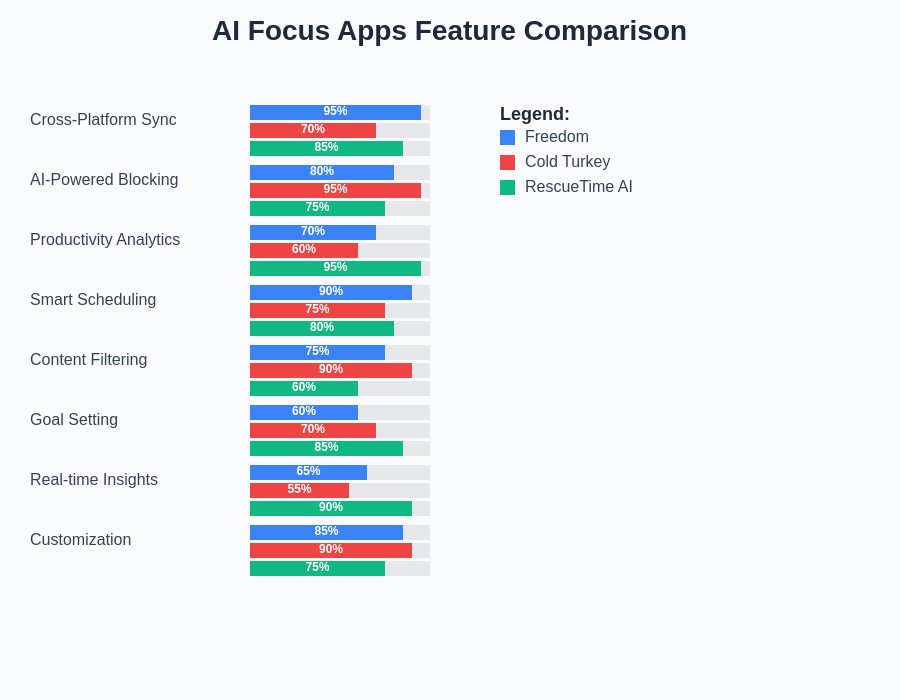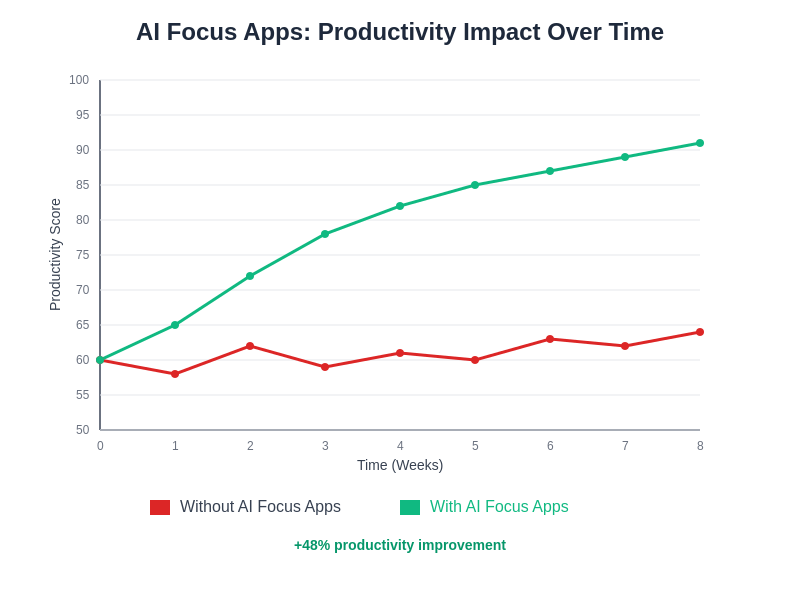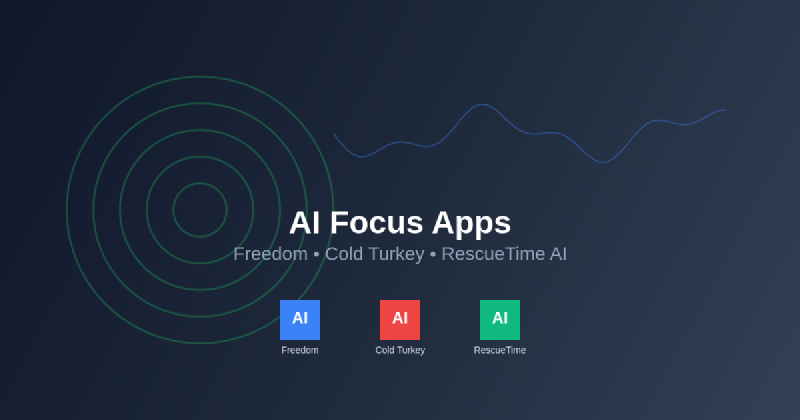The digital age has brought unprecedented connectivity and information access, yet it has simultaneously created an environment riddled with distractions that significantly impact our ability to maintain focus and productivity. In response to this challenge, artificial intelligence has emerged as a powerful ally in the battle against digital distractions, revolutionizing traditional focus and time management applications through sophisticated algorithms that adapt to individual behavior patterns and provide personalized interventions to enhance concentration and productivity.
Explore the latest AI productivity trends to discover cutting-edge technologies that are reshaping how we approach digital wellness and focus management. The integration of artificial intelligence into focus applications represents a fundamental shift from static blocking mechanisms to dynamic, intelligent systems that learn from user behavior and provide contextually appropriate interventions to maximize productivity while minimizing digital overwhelm.
The Evolution of Focus Applications Through AI Integration
Traditional focus applications operated on simple premise-response mechanisms, blocking predetermined websites or applications for specified durations without considering context, urgency, or individual productivity patterns. The introduction of artificial intelligence has transformed these rudimentary tools into sophisticated productivity companions that understand nuanced human behavior, recognize productive versus unproductive activities, and provide intelligent interventions that enhance rather than hinder legitimate work processes.
Modern AI-powered focus applications leverage machine learning algorithms to analyze vast amounts of user data, including application usage patterns, website visit frequencies, keystroke dynamics, and temporal productivity fluctuations. This comprehensive analysis enables these applications to develop personalized productivity profiles that inform intelligent blocking decisions, suggest optimal work schedules, and provide predictive insights about potential distraction triggers before they impact productivity.
The evolution from reactive to proactive focus management represents a paradigm shift that acknowledges the complexity of modern digital work environments. Rather than employing blanket restrictions that may interfere with legitimate work activities, AI-powered focus applications provide nuanced, context-aware interventions that support genuine productivity while effectively mitigating counterproductive digital behaviors.

This comprehensive methodology demonstrates how artificial intelligence transforms traditional focus management through continuous data collection, pattern analysis, behavioral prediction, and personalized interventions that create sustainable productivity improvements while adapting to individual work styles and environmental factors.
Freedom: Intelligent Cross-Platform Distraction Management
Freedom has established itself as a pioneering force in AI-enhanced focus management by developing sophisticated algorithms that provide comprehensive cross-platform blocking capabilities while incorporating intelligent learning mechanisms that adapt to individual user patterns and preferences. The application’s artificial intelligence continuously analyzes user behavior across multiple devices, identifying patterns that correlate with productive work periods versus distraction-prone intervals, enabling the system to provide increasingly accurate and personalized blocking recommendations.
The AI-driven scheduling feature represents one of Freedom’s most innovative contributions to focus management technology. By analyzing historical productivity data, application usage patterns, and temporal work rhythms, the system can automatically suggest optimal blocking schedules that align with individual circadian productivity cycles and work demands. This intelligent scheduling eliminates the need for manual configuration while ensuring that blocking interventions occur at moments when they will have maximum positive impact on productivity and focus.
Discover advanced AI assistants like Claude that can help analyze your productivity patterns and suggest personalized strategies for maintaining focus and achieving optimal work-life balance. The integration of multiple AI-powered productivity tools creates a comprehensive ecosystem that supports sustained concentration and meaningful accomplishment across diverse professional and personal contexts.
Freedom’s cross-platform synchronization capabilities demonstrate the power of AI in creating seamless productivity experiences that transcend individual device limitations. The application’s intelligent algorithms ensure that blocking configurations and productivity insights remain consistent across smartphones, tablets, laptops, and desktop computers, creating a unified focus environment that supports productivity regardless of the specific device being used for work or personal activities.
Cold Turkey: Advanced AI-Powered Blocking Technology
Cold Turkey represents the cutting edge of AI-enhanced website and application blocking technology, employing sophisticated machine learning algorithms that go far beyond simple URL filtering to provide comprehensive protection against digital distractions. The application’s artificial intelligence analyzes content patterns, user behavior sequences, and contextual usage data to identify and block potentially distracting content before it can impact productivity, even when such content appears on otherwise legitimate websites or platforms.
The application’s AI-driven categorization system automatically classifies websites, applications, and digital content based on their potential impact on productivity and focus. This intelligent classification goes beyond simple keyword matching to analyze content structure, user engagement patterns, and behavioral outcomes associated with different types of digital media. The result is a highly accurate blocking system that can distinguish between productive research activities and mindless browsing, even when both occur on the same platforms.
Cold Turkey’s adaptive learning capabilities enable the application to continuously refine its blocking algorithms based on individual user responses and productivity outcomes. The AI monitors how blocking interventions affect work quality, completion rates, and overall satisfaction, using this feedback to optimize future blocking decisions and ensure that interventions enhance rather than impede legitimate productivity goals.
The application’s intelligent scheduling features leverage artificial intelligence to predict optimal blocking periods based on calendar integration, work pattern analysis, and historical productivity data. This predictive capability allows Cold Turkey to automatically initiate blocking sessions before distraction periods typically occur, providing proactive rather than reactive focus support that prevents productivity disruption before it begins.
RescueTime AI: Comprehensive Productivity Analytics and Insights
RescueTime AI has revolutionized productivity tracking and analysis by incorporating advanced artificial intelligence algorithms that provide comprehensive insights into digital behavior patterns, productivity trends, and optimization opportunities that extend far beyond simple time tracking metrics. The application’s AI continuously analyzes user activity across all digital devices and platforms, creating detailed productivity profiles that reveal hidden patterns and provide actionable recommendations for improving focus and efficiency.
The artificial intelligence powering RescueTime goes beyond passive data collection to provide predictive insights about productivity trends, potential distraction risks, and optimal work scheduling opportunities. By analyzing correlations between various factors such as time of day, application usage patterns, website visit sequences, and resulting productivity outcomes, the AI can identify conditions that consistently lead to high-productivity periods versus those that typically result in distraction and inefficiency.
Enhance your productivity research with Perplexity AI for comprehensive analysis of productivity methodologies, focus techniques, and digital wellness strategies that complement AI-powered focus applications. The combination of multiple AI tools creates a robust framework for understanding and optimizing personal productivity systems across diverse work environments and professional contexts.
RescueTime AI’s goal-setting and achievement tracking capabilities demonstrate the power of artificial intelligence in translating abstract productivity aspirations into concrete, achievable objectives. The system analyzes individual productivity patterns and constraints to suggest realistic goals that stretch capabilities without creating unsustainable pressure. The AI continuously monitors progress toward these goals and provides dynamic adjustments and recommendations that account for changing circumstances and evolving priorities.
The application’s intelligent reporting features utilize artificial intelligence to generate personalized productivity insights that go beyond simple statistics to provide meaningful analysis and actionable recommendations. Rather than overwhelming users with raw data, RescueTime AI synthesizes complex behavioral information into clear, understandable insights that directly support improved decision-making about time allocation and focus management strategies.
Comparative Analysis of AI-Enhanced Focus Technologies
The landscape of AI-powered focus applications reveals distinct approaches to leveraging artificial intelligence for productivity enhancement, with each application offering unique strengths and specialized capabilities that cater to different aspects of digital wellness and focus management. Understanding these differences is crucial for selecting the optimal combination of tools that align with individual productivity goals and work environment requirements.

This comprehensive comparison reveals how Freedom, Cold Turkey, and RescueTime AI each excel in different aspects of focus management, from cross-platform synchronization and intelligent blocking to productivity analytics and personalized insights that support sustained concentration and meaningful work accomplishment.
Freedom excels in providing comprehensive cross-platform blocking capabilities that maintain consistency across diverse device ecosystems while offering intelligent scheduling features that adapt to individual productivity rhythms. The application’s strength lies in its ability to create seamless focus environments that support sustained concentration across multiple devices and platforms without requiring constant manual intervention or configuration adjustments.
Cold Turkey distinguishes itself through advanced blocking technology that employs sophisticated content analysis and behavioral pattern recognition to provide highly accurate distraction prevention. The application’s AI-driven categorization system and adaptive learning capabilities make it particularly effective for users who require nuanced blocking solutions that can distinguish between productive and unproductive activities within complex digital workflows.
RescueTime AI offers unparalleled insights into productivity patterns and behavioral trends through comprehensive analytics and intelligent reporting capabilities. The application excels in providing data-driven understanding of digital behavior patterns and offering evidence-based recommendations for productivity optimization that are grounded in actual usage data rather than generic productivity advice.
The Science Behind AI-Powered Focus Enhancement
The effectiveness of AI-powered focus applications stems from their ability to leverage scientific principles of behavioral psychology, cognitive neuroscience, and machine learning to create personalized interventions that align with individual brain function patterns and productivity preferences. These applications utilize sophisticated algorithms that analyze correlations between environmental factors, behavioral patterns, and productivity outcomes to identify optimal conditions for sustained focus and meaningful work accomplishment.
Research in cognitive neuroscience has demonstrated that attention and focus operate according to predictable patterns that vary based on circadian rhythms, cognitive load, environmental conditions, and individual neurological differences. AI-powered focus applications leverage this scientific understanding to provide interventions that work with rather than against natural cognitive processes, maximizing the effectiveness of focus enhancement strategies while minimizing resistance and cognitive strain.
The machine learning algorithms employed by these applications continuously refine their understanding of individual productivity patterns through analysis of vast datasets that include temporal usage patterns, application switching behaviors, productivity outcome correlations, and environmental context variables. This comprehensive analysis enables increasingly accurate predictions about optimal work conditions and potential distraction risks that inform intelligent intervention strategies.
Integration Strategies and Workflow Optimization
The most effective implementation of AI-powered focus applications involves strategic integration that leverages the complementary strengths of different tools while avoiding redundancy and configuration conflicts that can undermine overall productivity. Successful integration requires understanding how different applications interact with existing workflows and productivity systems to create synergistic effects that amplify rather than complicate focus management efforts.
Freedom’s cross-platform blocking capabilities provide an excellent foundation for comprehensive distraction management that can be enhanced by Cold Turkey’s sophisticated content filtering for specific high-risk activities and RescueTime AI’s analytical insights for understanding and optimizing overall productivity patterns. This layered approach creates multiple levels of focus support that address different aspects of digital distraction while providing comprehensive coverage across diverse work scenarios.
The key to successful integration lies in configuring these applications to work collaboratively rather than competitively, ensuring that blocking schedules align with analytical insights and that content filtering supports rather than interferes with legitimate productive activities. This requires thoughtful configuration that takes advantage of each application’s AI capabilities while maintaining flexibility for changing work demands and productivity goals.
Customization and Personalization Through Machine Learning
The true power of AI-enhanced focus applications emerges through their ability to provide highly personalized experiences that adapt to individual productivity patterns, work styles, and distraction vulnerabilities. Machine learning algorithms continuously analyze user behavior to identify unique patterns and preferences that inform increasingly sophisticated customization options that go far beyond simple preference settings.
These applications learn from behavioral patterns such as the types of distractions that prove most challenging during different work periods, the environmental conditions that correlate with peak productivity, the optimal duration and timing for blocking interventions, and the most effective types of feedback and motivation for sustaining focus. This learning process creates personalized productivity profiles that inform intelligent decision-making about when and how to intervene to maximize focus and productivity.
The personalization capabilities extend beyond simple behavioral pattern recognition to include predictive modeling that can anticipate productivity challenges before they occur. By analyzing correlations between various factors and their historical impact on productivity, these AI systems can provide proactive recommendations and interventions that prevent distraction rather than merely responding to it after productivity has already been compromised.
Privacy and Data Security in AI Focus Applications
The effectiveness of AI-powered focus applications depends on their ability to collect and analyze comprehensive data about user behavior, digital activity patterns, and productivity outcomes. This data collection raises important questions about privacy protection, data security, and user control over personal information that must be carefully considered when selecting and configuring these productivity tools.
Leading AI focus applications have implemented sophisticated privacy protection measures that include local data processing, encrypted data transmission, anonymized analytics, and comprehensive user control over data sharing and retention policies. These measures ensure that the benefits of AI-powered productivity enhancement can be realized without compromising personal privacy or exposing sensitive information to unauthorized access or misuse.
Users should carefully review the privacy policies and data handling practices of any AI focus application before implementation, ensuring that data collection and analysis practices align with personal privacy preferences and professional confidentiality requirements. The most reputable applications provide transparent information about data usage and offer granular controls that allow users to balance personalization benefits with privacy protection according to their individual preferences and circumstances.
Future Developments in AI-Powered Productivity Tools
The rapidly evolving field of artificial intelligence continues to create new opportunities for enhancing focus and productivity through increasingly sophisticated applications that leverage cutting-edge machine learning techniques, advanced behavioral analysis, and innovative intervention strategies. Future developments in this space promise to deliver even more personalized and effective focus enhancement tools that seamlessly integrate with diverse work environments and productivity methodologies.
Emerging technologies such as natural language processing, computer vision, and advanced behavioral modeling are being incorporated into next-generation focus applications to provide more nuanced understanding of productivity contexts and more intelligent intervention strategies. These technological advances will enable applications to better understand the difference between focused work and distracted browsing, provide more accurate predictions about optimal work conditions, and offer more sophisticated recommendations for productivity optimization.
The integration of AI focus applications with other productivity tools and systems represents another area of significant development potential. Future applications may seamlessly integrate with calendar systems, project management tools, communication platforms, and environmental control systems to create comprehensive productivity ecosystems that support focus and efficiency across all aspects of professional and personal digital activities.
Implementation Best Practices and Success Strategies
Successfully leveraging AI-powered focus applications requires thoughtful implementation that takes advantage of their sophisticated capabilities while avoiding common pitfalls that can undermine their effectiveness. The most successful users approach these tools with clear goals, realistic expectations, and a willingness to invest time in proper configuration and customization that aligns with their specific productivity needs and work environment requirements.
The implementation process should begin with careful analysis of existing productivity patterns and distraction challenges to identify specific areas where AI-powered interventions can provide the greatest benefit. This analysis should consider both obvious distraction sources and subtle productivity drains that may not be immediately apparent but significantly impact overall efficiency and work quality.
Configuration of AI focus applications should be approached iteratively, starting with conservative settings that provide basic distraction protection while allowing the AI systems to learn individual patterns and preferences. As the applications develop more sophisticated understanding of personal productivity patterns, settings can be gradually refined to provide more aggressive intervention while maintaining flexibility for changing work demands and unexpected productivity requirements.
Measuring Success and Optimizing Results
The effectiveness of AI-powered focus applications can only be properly evaluated through systematic measurement of productivity outcomes, focus quality, and overall satisfaction with digital work experiences. This measurement should go beyond simple metrics like blocked website attempts or tracked time to include qualitative assessments of work quality, stress levels, and overall satisfaction with productivity and focus management strategies.
Regular review of productivity analytics and AI-generated insights provides opportunities to identify trends, recognize successful strategies, and adjust configurations to optimize results. This review process should consider both short-term productivity fluctuations and longer-term trends that may indicate the need for strategic adjustments to focus management approaches.

The quantifiable benefits of AI-powered focus applications become evident through sustained usage, with users typically experiencing significant productivity improvements that compound over time as the artificial intelligence systems learn individual patterns and refine their intervention strategies for maximum effectiveness.
The most successful users of AI focus applications maintain flexibility in their approach, recognizing that optimal productivity strategies may evolve as work demands change, personal preferences develop, and AI capabilities improve. This adaptive approach ensures that focus management tools continue to provide value and support productivity goals rather than becoming rigid constraints that interfere with natural work rhythms and evolving professional requirements.
Conclusion: Embracing AI-Enhanced Digital Wellness
The emergence of AI-powered focus applications represents a significant advancement in digital wellness technology that offers unprecedented opportunities for enhancing productivity, maintaining focus, and achieving better balance in our increasingly connected world. These sophisticated tools demonstrate how artificial intelligence can be leveraged to support human flourishing rather than merely automating tasks, creating personalized experiences that adapt to individual needs and preferences while providing consistent support for sustained concentration and meaningful work accomplishment.
The continued evolution of these applications promises even greater benefits as AI technologies become more sophisticated and better integrated with diverse productivity systems and work environments. By thoughtfully implementing and optimizing these tools, users can create digital work environments that support their best efforts while protecting against the inevitable distractions and productivity challenges that characterize modern digital life.
The investment in understanding and properly utilizing AI-powered focus applications represents an investment in long-term productivity, professional effectiveness, and personal satisfaction that can pay dividends across all aspects of digital work and personal development. As these technologies continue to evolve, early adopters who develop expertise in their effective utilization will be well-positioned to maintain competitive advantages in increasingly demanding and distraction-rich work environments.
Disclaimer
This article is for informational purposes only and does not constitute professional advice regarding productivity tools, digital wellness strategies, or AI application selection. The effectiveness of focus applications may vary based on individual work styles, technical requirements, and personal preferences. Readers should evaluate their specific needs and conduct thorough research before implementing any productivity tools or digital wellness strategies. The views expressed are based on current understanding of AI focus applications and their capabilities as of the publication date.
